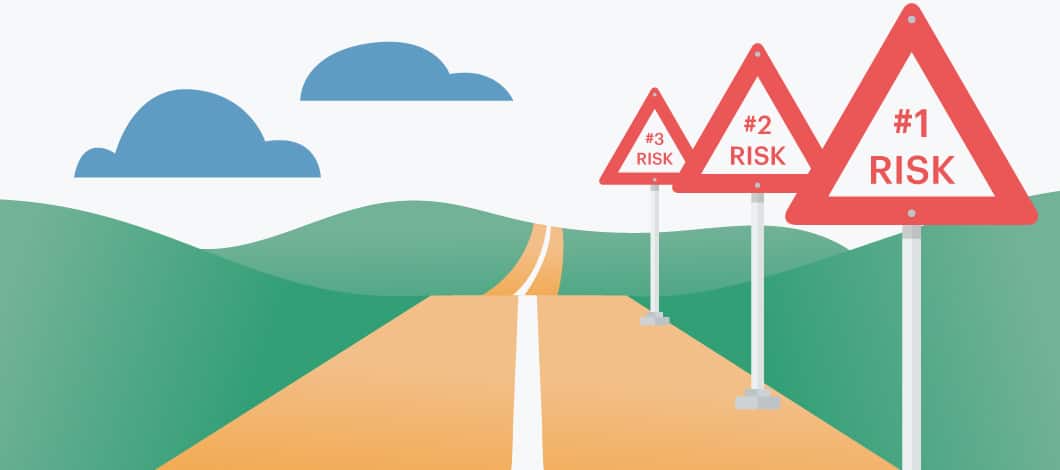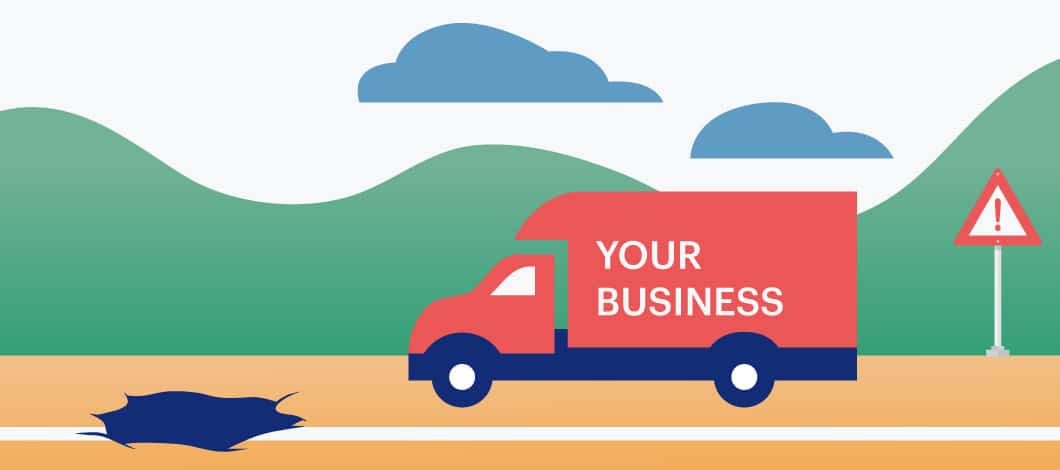A business contingency plan can help you prepare for emergencies such as the COVID-19 pandemic. Here are 7 steps you can take to avoid operational disruptions:
- Assemble a contingency planning team
- Identify and analyze potential risks
- Prioritize risks
- Develop preventive measures and responses
- Distribute your plan
- Test your plan
- Maintain your plan
Learn more about what a business contingency plan is, why you need one and how you can develop it to protect your company in the event of emergencies.
What Is a Business Contingency Plan?
A business contingency plan is a documented course of action your company prepares to take in case of a chance event — a contingency — that threatens to disrupt your operations. It also is sometimes referred to as a business continuity plan or a disaster plan.
A business contingency plan document typically covers:
- A list of potential risk scenarios
- An evaluation of the likelihood of each scenario
- An analysis of the potential impact of each scenario should it happen
- What preventive steps should be taken to avoid or mitigate each scenario
- What response should be taken in the event each scenario takes place
This type of planning can be applied to preparing for any type of business disruption, including:
- Financial emergencies, such as cash-flow crunches
- Staffing emergencies, such as medical emergencies or sudden loss of key personnel
- Supply-chain disruptions, such as manufacturing shortages
- Equipment disasters, such as machine failures
- Technical disruptions, such as network outages or payment-processing failures
- Security disasters, such as data breaches
- Natural and man-made disasters (hurricanes, pandemics, terror attacks, etc.)
- Legal disputes, such as lawsuits from injured or terminated employees
- A customer-relations crisis, such as negative publicity
These are just a few business continuity contingency plan sample scenarios. Depending on your business, you may face special risks specific to your industry, product or service.

So, Why Do You Need a Business Contingency Plan?
Having a contingency plan in business protects you against emergencies that could potentially disrupt your operations, hurt your cash flow or even drive you out of business. While it’s tempting to assume such contingencies are exceptional situations, some types of emergencies are all too common.
-
For Example
A survey by online payment platform provider WePay found 41% of businesses had experienced cash-flow challenges within the past year. Of these, 59% reported that the financial impact was either consequential or highly consequential. This type of scenario could easily drive a small company out of business.
Cybersecurity breaches represent another common emergency. In 2019, 28% of businesses reported suffering a data breach over 12 months, according to a survey by the National Cyber Security Alliance. Of these, 69% were knocked offline for a time, 37% suffered a financial loss, 25% filed for bankruptcy protection and 10% went out of business.
The spread of the novel coronavirus provides another example. At the beginning of the pandemic, the number of small businesses that felt comfortable about their cash-flow situation fell from 59% in March to 48% in May, according to research by MetLife and the U.S. Chamber of Commerce. Nearly 1 in 5 businesses were temporarily closed in May.
As these numbers illustrate, business emergencies happen frequently, and they can happen suddenly, sometimes with devastating effects. This makes it prudent for businesses to invest in developing contingency plans.
How Do You Go About Developing a Business Contingency Plan?
The heart of a business contingency plan is a set of standard operating procedures that detail how your company will respond in the event of specific risk scenarios. To develop this type of plan effectively, you first need to assemble a planning team to identify, analyze and prioritize risks.
To put your plan into practical use, you will need to distribute it to key personnel and test and maintain it. Following these steps will enable you to develop a contingency plan that you can implement if an emergency does arise:
1. Assemble a Contingency Planning Team
A preliminary step toward doing effective contingency preparation is to assemble a planning team. One person should be designated as the contingency planning leader. This individual will be responsible for:
- Managing overall contingency planning
- Coordinating communication between team members
- Getting input from key personnel
- Supervising risk identification, analysis and evaluation
- Overseeing development of preventive measures and responses
- Distributing contingency plan documents to key personnel
- Supervising contingency plan training and testing
- Keeping plans updated
To perform these duties effectively, the team leader should possess prerequisite skills, such as project-management experience. During the planning process, they will need to keep in touch with upper management as well as key personnel from departments involved in contingency planning. Depending on which risks are identified, departments that may be relied upon to provide input may include:
- Finance
- Accounting
- Information technology
- Marketing and sales
- Customer service
- Security
- Legal
The contingency planning leader should identify which personnel will be relied upon for expert input and who will be responsible for coordinating responses in the event of an emergency. For contingency planning to be effective, it’s critical for the planning leader to communicate with these key personnel.
2. Identify and Analyze Potential Risks
Your planning team’s first task should be to identify potential risks to your operations. Examples of potential risks include:
- Your in-store operations aren’t generating as much revenue as they did before the coronavirus pandemic
- Your cash flow falls short of your monthly expenses
- An employee in a key position is out with an illness or injury for an extended period
- Your company’s owner passes away unexpectedly
- Your suppliers inform you that they are running short on stock this month
- Your website server goes down
- Your company network gets hacked or infected with a computer virus
- A hurricane disrupts your business
- An employee gets injured on the job and files a claim
- A customer service issue generates a large number of public complaints on your social media profile
These are just a few business contingency plan example scenarios. For a comprehensive contingency plan, review all your operations and identify any potential scenarios that could disrupt them.
After identifying potential risks, you should analyze each scenario. Your analysis should evaluate:
- How likely each scenario is
- What impact each scenario would have on your business
You can use a business contingency plan template to identify and analyze risks. A simple way to create a template is to use a spreadsheet to list risk scenarios as rows, with columns dedicated to describing each scenario’s likelihood and impact, plus additional columns for preventive measures and responses.
When evaluating the likelihood of each scenario, you may find it convenient to use a simple scoring system. For example, you could use:
- 1 for extremely low risk
- 2 for moderately low risk
- 3 for moderately high risk
- 4 for extremely high risk
This allows you to quantify the likelihood of a given risk. Similarly, you can use a scoring system to measure the impact of a given scenario.
3. Prioritize Risks
After you’ve analyzed potential risks, the next step is to prioritize them. This is a necessary step because the process of developing contingency plans for risks consumes time and labor, and most businesses don’t have the need or the resources to cover every possible risk in equal detail. Strategically, it makes sense to address your greatest risks first.
If you use a scoring system to evaluate risks as suggested above, you can prioritize risks based on score. Scenarios that are more likely or which have a bigger potential impact should be prioritized above less probable or lower-impact scenarios.
You also can use criteria based on logical considerations to prioritize potential risks. For example, if your revenue model relies heavily on e-commerce, a contingency plan for online business continuity should be a high priority.
4. Develop Preventive Measures and Responses
After you’ve ranked your risks by order of priority, you can begin developing standard operating procedures to address each one. Your procedures should address 2 major areas:
- What preventive measures can be taken to prevent this scenario from arising?
- What response should be taken if this scenario does happen?
To illustrate, a financial contingency plan, for example, might call for the preventive measure of setting aside a percentage of revenue each month to create an emergency fund in the event of a cash-flow crisis. It also might include provisions to tap into a business line of credit in the event a financial emergency does arise.
Your contingency planning leader should develop preventive and responsive procedures in consultation with relevant company personnel and outsourcing partners. In some cases, you may wish to tap into the expertise of an outside consultant. For instance, you might hire a cybersecurity expert to review your network security risks and recommend preventive measures.
Preventive measures and procedures should be documented and stored in a place where they can be accessed by relevant personnel. This will help ensure that your contingency plan can be used in the event of an actual emergency. It will also make it easier to keep your plan updated.
5. Distribute Your Plan
After your planning leader has developed a rough draft of a contingency plan, it should be shared with relevant personnel who will be responsible for implementing the plan in the event of an emergency. This will allow you to get feedback on how to improve your plan. Your company’s planning leader then can incorporate this feedback to create a final draft of the plan.
Once a final draft has been agreed on, your plan should be distributed to key personnel for reference and use. An efficient way to distribute your plan is to create an area of your company’s intranet where management personnel and relevant workers can access it digitally.
As a contingency against the event of a physical disaster or a problem with your company’s network, be sure to create physical and cloud backups of your plan, with at least one physical copy stored at a different location than your on-site premises. These safeguards will ensure that you will be able to access your plan remotely even if your network goes down or there is a physical disaster at your site.
6. Test Your Plan
It’s crucial to ascertain that your contingency plan will actually work when you need it. The best way to do this is to run a test simulation of your plan.
For example, if you have a plan for what to do in a cash-flow crisis, you might have your accountant plug in some numbers for what will happen if your revenue level drops to a given point. The accountant then can run a simulation of whether your contingency measures would be adequate to offset the drop in revenue. As part of this simulation, you might want to check your credit score to verify that you could qualify for a loan or line of credit if needed.
Similarly, if you have a plan for what to do in the event of a company network outage, you might plan a simulated outage at a time when business is normally slow. This will give your team an opportunity to verify that your contingency plan will work when needed.
Testing also can serve as a training opportunity for personnel who will be responsible for putting your plan into effect in a real situation. It’s vital for key players to know what to do if a situation calls for activating your contingency plan. Running a test simulation will give them practical experience with putting your plan into effect.
7. Maintain Your Plan
Business contingency plans need periodic updating because of changes that may happen after their creation. For instance, if you have a plan for a cash-flow emergency and your monthly revenue or operational expenses change significantly, your plan needs to be adjusted to reflect your new numbers.
To make sure that your contingency plan stays up-to-date, schedule a periodic review of your plan document. Depending on the specifics of your plan, you may opt to review it on an annual, quarterly or even monthly basis.
You also can update your plan after you actually use it and observe how it works in practice. Take notes on how the plan implementation went, and if there were hiccups, make appropriate adjustments.
Protect Your Company With a Business Contingency Plan
Planning for emergencies is an essential part of a complete business plan and can protect your company in the event of a crisis. Effective planning starts with assembling a team to identify and analyze potential risks. You can then prioritize your highest risks to develop effective preventive measures and responses.
In order for your plan to be effective, it’s important to distribute your plan to key personnel and test and maintain it to make sure that it works and stays up-to-date. Put these steps into effect to protect your business from unexpected disruptions. When it comes to contingency planning, it’s better to be safe than sorry.












